The Climate Imperative
Immediate action is needed to reduce greenhouse gas emissions and put the world on a path to a reasonable climate future. Reducing global greenhouse gas emissions is no small task. But the technologies, policies, and motivation to achieve this reduction exist today; it is a matter of adopting, designing well, and then promptly implementing the right policies.
The vast majority of greenhouse gas emissions come from a small set of countries; their source is predominantly energy use, such as power plants, vehicles, and buildings, and industrial processes, such as cement or iron and steel manufacturing. Focusing on energy use and industrial processes has the largest emission abatement potential.
A dozen highly effective policies in the biggest countries can put us on the right path to significantly reduce emissions from these sectors. These policies must be designed well to achieve lasting reductions. Decades of experience with both good and bad policy design has illuminated the characteristics that separate good from bad policy.
For example, policies tend to stagnate and become obsolete without built-in mechanisms for continuous improvement. And without a sufficiently long time horizon, businesses cannot invest in the technology or research and development (R&D) needed to produce better equipment. A handful of policy design principles can ensure that future climate and energy policy maximizes greenhouse gas reductions and economic efficiency. These policies leverage the trillions of dollars of private capital already spent each year to build a clean energy policy.
In other words, these principles can drive effective, investment-grade policy.
This website and our book drills down into these policies, their design principles, and their potential impact on global emissions. This material is a resource to policymakers, CEOs, non-government organizations, research institutions, and philanthropists who are searching for the fastest, most effective way to make a difference and reducing the threat of climate change.
In Climate, Delay Is Killer
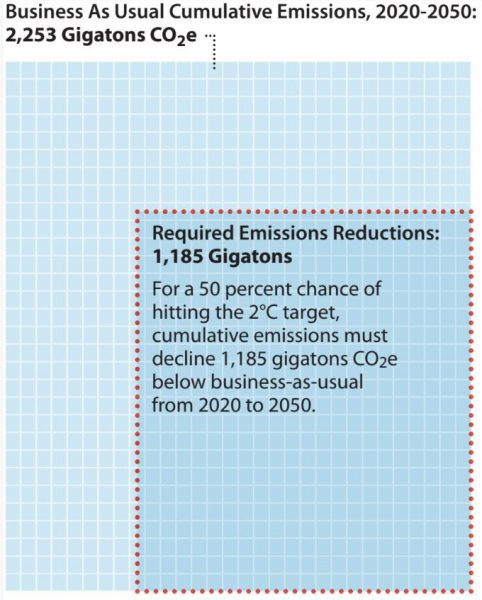
Emissions reductions required for a 50% chance of avoiding 2°C global warming.
There is broad consensus that preventing the worst impacts of climate change requires keeping global warming below two degrees Celsius through the end of the 21st century. This, in turn, requires steep cuts in greenhouse gas emissions. Climate models vary, but to have an even chance of staying under two degrees, we need to avoid 25% to 55% of cumulative emissions between now and 2050 compared with the business-as-usual case. These reductions vary significantly by region, with steeper reductions needed for more advanced economies. Furthermore, whereas cumulative emission reductions of 25% to 55% are required, annual emissions in 2050 must be lower still, on the order of 40% to 70% below business-as-usual emissions.
The scope, scale, and irreversibility of climate change—and the irreducible mathematics of carbon accumulation—together mean that swift action to abate greenhouse gas emissions is imperative. Failing to take immediate action to reduce emissions could result in significant damage: loss of coastal lands to sea level rise, threatening more than a billion people; mass refugee migration; famines; a wave of extinctions; and other impacts that will take an economic, ecological, and human toll. Rising seas in Bangladesh, for example, could produce 35 million refugees, seven times the number generated by the crisis in Syria, which has shaken the political stability of Europe. Scientists predict up to a 40% reduction in East Africa’s wheat and maize production from heat alone. It is a grim list—and a long one.
The seriousness of the threat and the limited time to tackle it are both a consequence of scientific facts about Earth’s biogeochemical systems. Small shifts in average global temperature have outsize consequences. Three important factors drive this magnification: the way in which those shifts increase the frequency of extreme temperature and weather events, the irreversibility of warming on reasonable timescales, and the danger of triggering natural feedback loops that cause additional warming.
Extremes Become the Norm
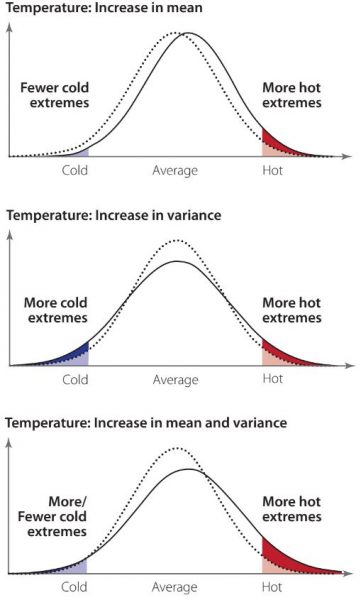
Higher and more variable temperatures will lead to greater temperature extremes. Source: Intergovernmental Panel on Climate Change.
Any given place on Earth experiences a range of temperatures, both day to day and year to year. Consider the average summer temperature in the United States: In certain years, the country experiences unusually cool summers, and in other years it experiences particularly hot summers. But in most years, the summer temperature is around average for that time of year.
Increasing the average global temperature makes previously rare extreme temperatures become much more frequent. This has the effect of making cooler summers rare and really hot summers more common. We are already starting to experience these effects, as exceptionally hot summers that occurred less than once every 300 years or so from 1951-1980 represented a significant fraction of all summers from 2005-2015.
This effect is projected to become much worse in the future. Even with an average global increase of just a few degrees, many areas in the U.S. that today see just a few days with highs of at least 100°F will see many more such days by the end of the century.
For example, “by the middle of this century, the average American will likely see 27-50 days over 95°F each year—two to more than three times the average annual number of 95°F days we’ve seen over the past 30 years. By the end of this century, this number will likely reach 45-96 days over 95°F each year on average.” In other words, by the end of this century, sections of Texas, Arizona, and California could swelter in such conditions for a third of the year or more.
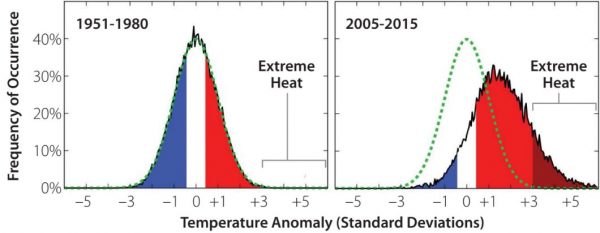
Climate change is shifting global temperatures, making extreme heat more frequent. Source: James Hansen et al.
These exceptionally hot summers cause severe damage, because they are beyond the typical range to which human and natural systems have adapted. For example, exceptionally hot conditions dry out the landscape, intensify wildfires, devastate crop and livestock yields, send people to the hospital with heat stroke, and cause many other harms.
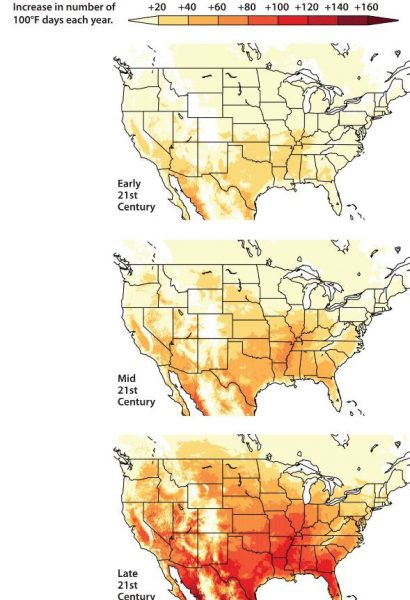
The number of days with temperatures above 100°F may increase significantly as climate change worsens. Source: National Climate Assessment.
The Irreversibility of Warming on Reasonable Timescales
Once a quantity of greenhouse gas is emitted, it will begin cycling out of the system as various natural cycles pull it out of the atmosphere. For example, carbon dioxide (CO2), the most important greenhouse gas, may dissolve into the ocean, and methane eventually breaks down into CO2. For many greenhouse gases, it takes a very long time to remove nearly all the pollutant from the atmosphere. The natural removal rate for CO2 is slow—it may take hundreds or thousands of years without human emissions for CO2 to return to its natural concentration. Likewise, it may take hundreds of years to eliminate almost all atmospheric nitrous oxide (a strong greenhouse gas) and many thousands of years for various fluorinated gases, which are very strong greenhouse gases. Indeed, much of the carbon dioxide emitted at the very start of the Industrial Revolution—about 250 years ago—is still present in the atmosphere today.
The climate system also has a great deal of inertia. That is, climate change is a problem of stocks, not flows. One way to visualize this is to think of the atmosphere as a bathtub: As carbon dioxide is emitted (the faucet), it continues to add to the total CO2 concentration in the atmosphere (the bath water). CO2 is then removed by natural processes over many years (the drain). Like a bathtub in which the water level will continue to rise as long as there’s more water flowing in than draining out, even a dramatic reduction in CO2 emissions will not reduce concentrations as long as emissions outpace removals.
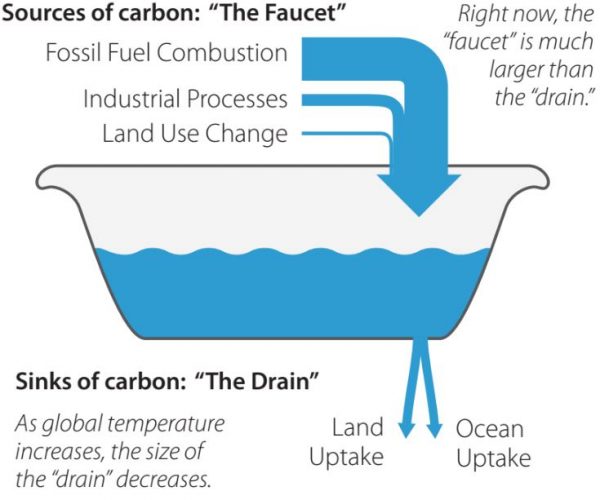
Greenhouse gas emissions and concentrations are like a bathtub, with emissions being the faucet, concentration being the tub, and sinks being the drain. Source: U.S. Environmental Protection Agency.
Even if we were to completely stop emitting greenhouse gases today, the impacts of the previously emitted gases would continue to be felt for thousands of years, because the total stock of carbon in the atmosphere (the bath water) remains high. Once in the atmosphere, CO2 and other greenhouse gases trap heat in the atmosphere, and the effects of that trapped heat manifest over time. As a result, we will continue to see increasing impacts on human society and natural systems for thousands of years after stabilizing the greenhouse gas concentration in the atmosphere.
Note in the chart below that greenhouse gas emissions (in carbon dioxide equivalent, or CO2e), which are caused by human activity, are driven to near zero, while greenhouse gas concentrations barely decline, and greenhouse gas impacts (temperature) keep growing.

Even if emissions were to peak and drop to zero immediately, CO2 concentrations and temperatures would continue to increase. Source: International Institute for Applied Systems Analysis.
The Danger of Natural Feedback Loops
One of the most disturbing aspects of global warming is that as the world heats up, natural feedback loops kick in that intensify the warming. Although anthropogenic (human-caused) emissions may be the initial catalyst in warming the globe, Earth’s natural systems can exacerbate this impact, creating what physicists call a positive feedback loop, which is more easily understood as a vicious cycle. One vicious cycle is the impact melting sea ice has on Earth’s absorption of heat: Bright sea ice has a high albedo, meaning it reflects (rather than absorbs) most of the light that hits it. Dark sea water has a lower albedo, meaning it absorbs the light that hits it, which turns into heat. As ice melts from warming temperatures, areas previously covered with reflective white ice become uncovered with absorptive blue ocean water, which increases heat absorption and further accelerates warming.
A similar vicious problem occurs with melting arctic tundra: As once-frozen tundra thaws from warmer temperatures, buried methane deposits are released, causing more greenhouse gases to enter the atmosphere and warm the world further. The scale of this greenhouse accelerator, once released, is almost unfathomable, and once it starts, it cannot be controlled.
Yet another is the absorption of CO2 in oceans: As oceans absorb more CO2, water becomes more acidic, causing the die-off of aquatic plants and animals, whose decomposition contributes additional CO2 to the oceans and atmosphere.
It is unclear exactly how much these feedback loops will exacerbate climate change. But their potential to accelerate warming is frightening—and the fact that these forces become uncontrollable once unleashed means climate action is necessary immediately.
Delay is Costly
Another reason for acting as soon as possible to reduce emissions is that the challenge of cutting emissions enough to avoid exceeding two degrees of warming will get increasingly difficult as reductions are delayed. Delaying is costly for two reasons. First, most energy-consuming assets—buildings, power plants, industrial facilities—have a turnover rate of decades or more, meaning we essentially lock in a higher level of warming with each piece of new equipment we adopt or install. Second, because warming is a function of the total amount of CO2 in the atmosphere, delayed action on emission reductions makes it far harder to achieve the same concentration of CO2 in the future.
For example, the graph below shows how a 15-year delay in peak emissions requires greater emissions reductions, faster, to achieve the same cumulative level of emissions. Note that not only is the emission reduction rate higher in each subsequent year, but the total level of emissions, particularly in the latter half of the century, must be lower to account for the higher emissions early on. The sooner action is taken, the easier it will be to meet the two-degree target. Waiting even a few years can significantly exacerbate the challenge of keeping warming below two degrees.

The longer the delay in peaking emissions, the harder it becomes to meet the same carbon budget.
Delay comes with significant costs, too. An analysis by eminent British economist Lord Nicholas Stern in the Stern Review shows that stabilizing greenhouse gas concentrations at 500–550 parts per million (ppm), or about 100–150 ppm higher than today’s concentration and nearly double the pre–Industrial Revolution concentration of about 280 ppm, would cost approximately 1% of global economic output (gross domestic product [GDP]) per year, whereas the costs of inaction would mount to 5%–20% of global GDP per year from the costs of climate change impacts.
The physics of Earth thus give us the following imperatives: The problem is enormous, it is urgent, and failure would be irreversible. Fortunately, there is still time to achieve a reasonable climate future and many reasons to think it can be done. But time is of the essence; this option does not last long.
Reasons for Hope
The effects of climate change are worrisome, to say the least. Emission reductions are needed as soon as possible to avoid the worst of these effects. Fortunately, there is ample technology to put the world on a low-carbon trajectory. It is backed by growing political momentum.
Renewable Energy
Transitioning to a low- or zero-carbon electricity system is no longer a dream of the future. Costs for wind and solar power have plunged, propelling their growth around the world. Contracts for U.S. wind projects have been coming in at less than half the price they were just five years ago and cheaper than any other new power source worldwide. Contracts for solar power in some parts of the world are coming in at the same or a better price.
To put these cost declines into context, consider that recent projects in Chile and Dubai have been contracted at less than 3 cents per kilowatt-hour (kWh), without any subsidy, compared with residential electricity rates in the United States of nearly four times that amount. The costs of solar photovoltaic systems are projected to fall even further—below $1.00 per watt by 2020—and wind power costs are projected to decline by as much as 30% by 2030.
Low prices are setting in motion a rapid buildout of new power plant capacity. Wind installations have more than doubled since 2010, with more than 430 gigawatts (GW) installed worldwide. Meanwhile, global solar installations nearly quintupled between 2010 and 2015, reaching 227 GW at the end of that period. Prices will decline even further as more capacity is built out, creating a virtuous cycle of more, cheaper clean power projects.
Battery storage has experienced similar cost declines. Within just a year and a half, the price of lithium-ion batteries has declined 70%, and prices are estimated to continue to drop nearly 50% in the next five years. Flow batteries and new chemistry batteries are also expected to witness major cost reductions within that timeframe. Research suggests large-scale battery storage could grow to more than 7 GW globally and cost as little as $230 per kWh by 2030.
As more renewable electricity capacity comes online, grid operators are becoming better and more adept at integrating it into the electricity system. In some regions, renewables already make up more than half of all generation. It is now possible to envision a future in which renewables make up 80% or more of electricity generation, enabling deep carbon reductions. No additional technological breakthroughs are needed to meet these penetration levels.
Deploying these technologies comes with other benefits as well. Renewables such as wind and solar are zero-emission sources, meaning they have the co-benefit of reducing local air pollutants, such as particulates and ozone. And because these sources use no fuel to generate electricity, they are essentially free to operate once installed, meaning electricity will continue to get cheaper.
Energy Efficiency
Innovation in energy efficiency continues as well. Well-constructed buildings today use a fraction of the energy that older buildings use, thanks to advances in lights, windows, insulation, and heating and cooling systems—all while maintaining or even improving comfort and energy reliability. Home appliances, industrial equipment, and vehicles have also become more efficient, providing the same or better service while using much less energy to operate.
The proliferation of light-emitting diode (LED) light bulbs is one of the most successful examples of innovation in energy efficiency. Since 2008, the efficiency of LEDs has approximately doubled, while prices have declined by 90%. New LEDs use about one-eighth as much energy as the incandescent bulbs they replace and last about 20 times longer. As a result, more than 80 million LED bulbs have been installed in the U.S. today, which have avoided millions of tons of CO2 emissions and saved billions of dollars. Lighting is responsible for approximately 20% of the world’s building sector electricity consumption, meaning efficiency gains in this realm and others can add up to real energy and emission savings.
In all, the International Energy Agency (IEA) calculates that energy efficiency investments in IEA countries have saved 2,200 terawatt-hours of electricity—more than a tenth of global electricity consumption in 2015—avoiding more than 10 billion tons of CO2 and saving $550 billion in avoided energy costs. By 2030, it is estimated that improved lighting efficiency could result in electricity savings equivalent to current electricity demand for all of Africa.
With these advances in renewable energy and energy efficiency technologies, many countries have decoupled or are beginning to decouple their energy use from economic productivity. Growth in the clean energy industry has created millions of new jobs, and prices for renewable energy sources and efficiency are now competing with (and often beating) prices for fossil fuel energy. A low-carbon future now costs the same as or less than a high-carbon one.
We Know Which Policies Can Achieve Effective Emissions Reductions
Decades of energy policy examples have highlighted which policies are most effective in reducing carbon emissions and energy use. For instance, we know a strong building code that continuously strengthens over time and has a strong monitoring and enforcement mechanism, as in California, can dramatically reduce energy use and emissions. And we know fuel economy standards for vehicles, when designed well, can dramatically improve fuel efficiency.
We also now have resources that can help parse through the available policy options. The Energy Policy Simulator, which allows users to evaluate the impact of hundreds of different climate and energy policies on emissions and costs, is one such tool. Another resource is the Clean Energy Solutions Center, which connects policymakers with experts who can help craft effective climate and energy policy.
The World is Embracing These Technologies and Policies
The political will to enact strong climate and energy policies is stronger than ever. From local city ordinances to international treaties, politicians are lining up to put strong policies into action. At the international level, 189 countries have submitted emissions targets (intended nationally determined contributions [INDCs]) and signed the Paris climate treaty. These commitments, which cover nearly 99% of the world’s total emissions, are the first step in the battle to limit climate change. If met by all countries on time, the targets get the world about one-third of the way to the global goal of limiting climate change to tolerable levels. Of course, pledges don’t result in emission reductions; strong climate and energy policies with stringent monitoring and enforcement will be key to turning the commitments into real emission reductions.
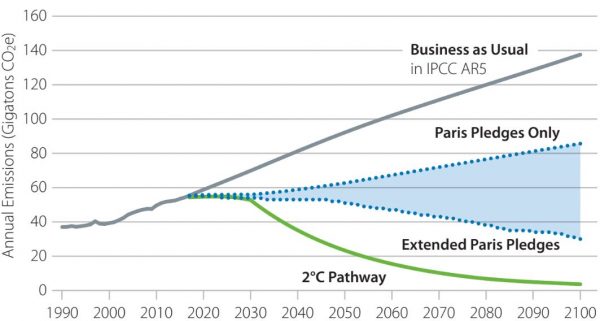
Pledges made as part of the Paris Agreement get us part way to the 2°C Pathway. Source: Climate Interactive and Climate Action Tracker.
The private sector is also embracing a low-carbon future. Businesses around the world are making ambitious pledges to cut their emissions. Nearly 180 companies, from Autodesk to Xerox, have signed the Science Based Targets initiative, setting emissions reduction targets. Beyond this pledge, 69 companies have joined the RE100 initiative, committing to 100% renewable power – and many are more than halfway to meeting this target.
Other public sector organizations, faith-based groups, foundations, and universities have also shown their support for curbing emissions by pulling their investments out of fossil fuels. In total, more than 550 institutions with assets of $3.4 trillion (a much smaller portion of which is invested in fossil fuels) have divested.
Consumers, too, are shifting their behavior to reduce their carbon footprint. Households are installing solar panels (or, where that’s not feasible, opting into green power programs offered by their utilities or joining community solar programs), buying energy-efficient appliances, and driving electric vehicles (EVs). For EVs specifically, more than a million have been sold around the world—reflecting breakneck growth rates from nearly zero just five years ago— and millions more are estimated to hit the roads in coming years as technology advances and production costs decline further.
In many cases, people take these actions purely because they are turning out to be cheaper than continuing their behaviors as usual. Smart energy devices such as thermostats and lighting systems are saving consumers money while improving comfort.
Development in low-emission technologies is providing a wide array of options for emission abatement. However, to have a shot at a reasonable climate future, policymakers will need to help push these technologies into the marketplace, and that requires smart policy. To figure out which policies can help achieve these goals, it is critical to quantify each major source of greenhouse gas emissions.
The Sources of Greenhouse Gas Emissions
There is no way to achieve a reasonable future unless the world focuses, first and most intensively, on the highest-potential abatement opportunities. The first step in this process is to identify the sources of greenhouse gas emissions around the world. Nearly 75% of global greenhouse gas emissions are generated by just 20 countries. Focusing efforts in these countries offers the highest potential for emission reductions.
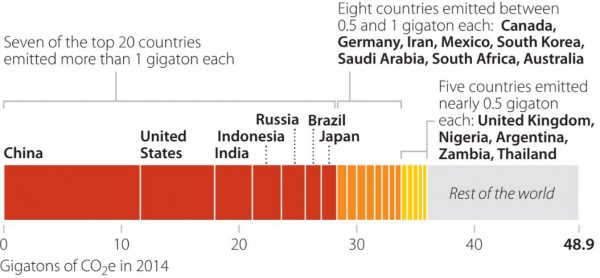
The top 20 emitting countries are responsible for roughly 75% of global emissions. Source: World Resources Institute.
Globally, and especially within the top 20 countries, emissions from energy combustion and industrial processes (which in this book include agriculture and waste) are the primary source of greenhouse gases, comprising more than 93%. Energy makes up nearly 74% of emissions, with industrial processes coming in at just under 20%. Targeting emissions from energy and industrial processes has the greatest potential for reductions.
Drilling down into the energy sector, emissions are fairly evenly spread across subsectors. The electricity sector is responsible for the largest share of emissions due to the combustion of coal, gas, oil, and biomass for power generation. Next up is industry, with emissions from energy combustion for electricity and heat. Transportation is third, followed by buildings. Of course, many sectors are interrelated: The efficiency of building components determines the amount of electricity used by buildings, and the quality of building construction affects the amount of materials needed to fix existing buildings or build new ones, driving industrial energy use and emissions.
Industrial process emissions are dominated by emissions related to livestock, natural gas and petroleum systems, cement production, landfills, and refrigerants.
This quantitative assessment points toward a straightforward roadmap for reducing energy-related emissions: Implement policies that reduce emissions in the electricity, industry, transportation, and building sectors in the top 20 emitting countries.
Essential Climate and Energy Policy
Effective energy and climate policy needs a suite of policies; there is no silver bullet in this business. To design an optimal suite of policies, a policymaker should consider policies of four broad types: performance standards economic signals, support for R&D, and enabling policies. Together, they create a powerful symbiosis that can drive deeper carbon emission reductions than policies in isolation while increasing cost-effectiveness.
- Performance standards: Performance standards set minimum requirements for energy efficiency, renewable energy uptake, or product performance. Examples include vehicle fuel economy standards, energy-efficient building codes, renewable portfolio standards, and power plant emission limits.
- Economic signals: Economic signals are policies designed to accelerate the adoption of clean energy technologies, ensure that positive and negative social impacts (i.e., externalities) are incorporated into product costs, or otherwise use the market as a tool for efficiently achieving emission reductions. Examples include carbon taxes and subsidies for clean energy production or efficiency upgrades.
- Research and development support: Government support for R&D can accelerate innovation. New technology spurs economic development and reduces reliance on expensive and volatile fossil power sources. Government support can come in the form of funding for basic research (on technologies far from commercialization) intended to benefit many new industries. However, one of the most powerful ways government can support R&D is by creating an environment where private sector R&D can thrive. Examples include sharing technical expertise and facilities (such as national laboratories); adopting appropriate intellectual property protections; promoting robust science, technology, engineering, and mathematics education in public schools and universities; and structuring immigration laws so companies are not prevented from hiring foreign talent in science, technology, engineering, and math (STEM).
- Supporting policies: Supporting policies enhance the functionality of the other policies, often through direct government expenditures, information transparency, or reduction of barriers to better choices. For example, a policy requiring clear energy use labels on products allows consumers to make smarter decisions, and good urban design gives people transit options other than driving their car, enabling them to respond to well-designed economic signals.
When setting energy policy, it is best not to fall in love with a particular technology or a particular policy. For example, neoclassical economists love economic signals, such as carbon taxes. This is indeed the best policy for sectors that are highly price sensitive and for which there are low-carbon alternatives at near-competitive prices. But it may prove quite limited in other circumstances. R&D support wins the hearts of many a technologist, but this strategy does little to bend the practices of incumbent companies seeking to recover the costs of old technology, such as coal plants.
The beginning of wisdom in selecting a policy type is to map the technology, or the problem to be solved, on a learning curve, which shows how a technology price changes as the volume of production increases.
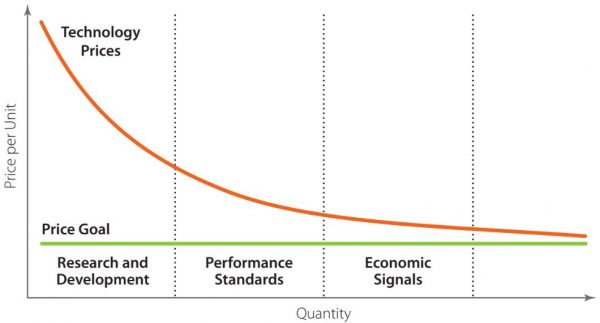
The policy-technology learning curve (illustrative).
Advanced nuclear power, carbon capture and sequestration, algal fuels, and dozens of other intriguing options require serious, sustained R&D. R&D, and innovation in general, has been one of America’s greatest strengths, but we have shorted it, both in quantity and at times in management, so we do not have the shelf of options we should.
Once the basic principles of a technology are proven and early production is under way, a big and costly effort is needed to drive the price down to a reasonable level. We have seen this work dramatically in the last decade with wind and solar power, which experienced price drops of more than 80% and 60%, respectively. Over a slightly longer period, refrigerator energy consumption dropped by 80%. This improvement was realized because a number of jurisdictions set clear performance standards for those technologies.
Today, offshore wind, central station solar, zero-net- energy buildings, and other technologies can improve most quickly if backed by clear performance standards. It’s worth noting that performance standards are common and commonly accepted by even the most hardcore economists in many realms: Our building codes ensure that buildings don’t easily burn or fall down, meat standards prevent innumerable cases of poisoning, and clean water is rightly considered a right.
Finally, for many sectors and technologies, pricing is the key. Removing subsidies for fossil fuels is the first step—though still widely ignored. Next, policymakers must incorporate the cost of externalities, such as adding a carefully derived social cost of carbon or setting a carbon cap.
Prioritizing Policies for Emissions Reduction
Policymakers have many options available to them to reduce emissions from energy and industrial processes. The first step in evaluating which policies to prioritize is to assess the structure of the economy and emissions. Knowledge about how many cars, buildings, and power plants there are, how much energy they use, how their use is expected to grow over time, and so on can highlight which areas of the economy should be a focus for emission abatement.
The next step is to quantitatively evaluate the potential for policies to reduce emissions. Often this is done through marginal abatement cost curves, which look at the ability and cost-effectiveness of specific technologies to reduce emissions. A new advance, and improvement, is to instead evaluate the ability and cost-effectiveness of specific policies to reduce emissions, through policy cost curves. An analysis grounded in policy rather than technology gives policymakers a more direct path to emission reductions because it taps into their ability to implement policy.
Not every country needs to conduct all these analyses. Some regions will be quite similar to others that have already conducted some or all of these assessments, in which case similar findings will apply. Additionally, decades of experience in policy design backed up by quantitative computer modeling demonstrate that a small set of these policies, designed well, can effectively reduce emissions.
| Power Sector | Transportation Sector | Buildings Sector | Industry Sector | Cross Sector |
| Renewable Portfolio Standards and Feed-in Tariffs | Vehicle Performance Standards | Building Codes and Appliance Standards | Industrial Energy Efficiency Policies | Carbon Pricing |
| Complementary Power Sector Policies | Vehicle and Fuel Fees and Feebates | Industrial Process Emissions Policies | Research and Development Policies | |
| Electric Vehicle Policies | ||||
| Urban Mobility Policies |
In the power sector, renewable portfolio standards and feed-in tariffs can reduce emissions by increasing the share of fossil-free power generation. Designed well, they can minimize the costs of transitioning to a low-carbon power system. Complementary power sector policies, such as support for transmission, smart utility policy design, and efficiency resource standards, are important as well.
Strong standards and incentives to improve industrial energy efficiency can significantly reduce emissions from the industrial sector. The industry sector also has significant process emissions, which include emissions of CO2 and other non- CO2 gases generated in industrial processes. Policymakers can require control of these emissions and offer incentives and other forms of assistance to encourage reductions.
In the building sector, building codes and appliance standards are the best tools for reducing emissions. These policies tend to save money as well, because over time decreased energy use outweighs any increase in costs.
Fuel economy standards, vehicle feebates, electric vehicle incentives, and smart urban planning can all reduce emissions significantly in the transportation sector by increasing the fuel efficiency of vehicles, decreasing their emissions, and offering alternative transportation options.
Carbon pricing is another strong tool for reducing emissions, encouraging emission-reducing behavior across the economy and pushing investments to lower-carbon options.
Finally, support for research and development policies helps reduce the costs of all of these policies while providing opportunities for new low-carbon technologies to hit the market.
Conclusion
Climate change requires action as soon as possible to limit emissions and avoid exceeding two degrees of warming. Governments, businesses, and organizations around the world have committed to reducing emissions, laying the foundation for deeper emission cuts that put the world on a trajectory to a lower-carbon future. The key now is in turning these pledges into reality—with laser-focused, well-designed policy.
This task is by no means impossible. We have the technology today to rapidly move to a clean energy system. And the price of that future, without counting environmental benefits, is about the same as that of a carbon-intensive future. So the challenge is not technical, nor even economic, but rather is a matter of enacting the right policies and ensuring they are properly designed and enforced.